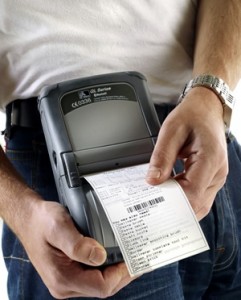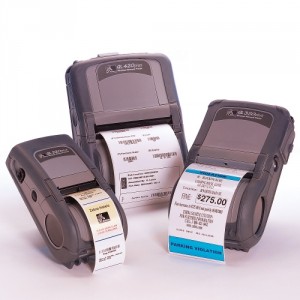 In a recent blog post inspired by Zebra Technologies’ white paper, Wireless Printing Delivers Efficiency and Cost Savings in Retail, I recalled the bad-old days when the mobility of every electrical appliance was limited by the length of its heavy power cord. As for wireless communications, those were all one-way exchanges consisting of transmissions rated in kilowatts of ERPs and received by furniture-sized home appliances also plugged into wall outlets. When portable, battery-powered transistor radios were introduced, I felt sure life could get no better – radio went with me everywhere! Anyway, those were just some of the memories Zebra’s white paper conjured.
In a recent blog post inspired by Zebra Technologies’ white paper, Wireless Printing Delivers Efficiency and Cost Savings in Retail, I recalled the bad-old days when the mobility of every electrical appliance was limited by the length of its heavy power cord. As for wireless communications, those were all one-way exchanges consisting of transmissions rated in kilowatts of ERPs and received by furniture-sized home appliances also plugged into wall outlets. When portable, battery-powered transistor radios were introduced, I felt sure life could get no better – radio went with me everywhere! Anyway, those were just some of the memories Zebra’s white paper conjured.
I shop frequently at a local dollar-type store, which, as it happens, is one of the highest-grossing locations of that highly successful chain. The store’s rapid inventory turnover necessitates restocking during store hours, and its busy, narrow aisles make that a challenge for both its customers and its team of stockers.
While shopping there recently, I noticed its manager and one of its young stockers trying to figure out where to best display a delivery of paper products, which sounds simple until you realize that their problem is complicated by the fact that the inventory they manage is exceptionally dynamic. They may have to stock a shelf-full of Brand-X toilet paper today, only to replaced it by a shelf and a half of Brand-Z tomorrow.
There they stood, strips of preprinted shelf-edge labels in hand, afraid to pull the trigger on affixing them for fear of having to shuffle the toilet-paper again to make room for other stock that they might not have anticipated.
 So, I mentioned that Zebra Technologies offered the perfect solution: Wireless mobile printers, such as Zebra’s QL series, would allow them to print and reprint – in aisle – shelf-edge labels as they were needed. No more fumbling through strips of preprinted labels or worrying about affixing those labels prematurely. Although the manager was enthusiastic about the idea, her reaction wasn’t nearly as telling as that of the young stocker who dealt with the problem shift after shift. When I showed him an image of the QL220 on my smart-phone, he saw realized instantly the dramatic impact that wireless, portable printer could have on his typical workday.
So, I mentioned that Zebra Technologies offered the perfect solution: Wireless mobile printers, such as Zebra’s QL series, would allow them to print and reprint – in aisle – shelf-edge labels as they were needed. No more fumbling through strips of preprinted labels or worrying about affixing those labels prematurely. Although the manager was enthusiastic about the idea, her reaction wasn’t nearly as telling as that of the young stocker who dealt with the problem shift after shift. When I showed him an image of the QL220 on my smart-phone, he saw realized instantly the dramatic impact that wireless, portable printer could have on his typical workday.
As I excused myself to continue shopping, I overheard the stocker ask his manager, “If the company won’t buy those label printers for our store, do you think they’d get mad if I bought one of my own to use here?” And just think, that kid is too young to know that so many other aspects of life were once similarly limited by the reach of power and communication cords.













